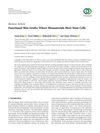A Novel Immune Competent Murine Hypertrophic Scar Contracture Model: A Tool to Elucidate Disease Mechanism and Develop New Therapies
October 2014
in “
Wound Repair and Regeneration
”
TLDR The model helps understand scar contraction and develop new treatments.
This study developed a novel immune-competent murine model for hypertrophic scar (HSc) contraction using female C57BL/6 mice to simulate third-degree burns and skin grafting. The model aimed to address the lack of effective therapies for HSc contractures, which impact quality of life. It demonstrated that grafts contracted to about 45% of their original size by day 14, similar to human behavior, and showed increased cellularity, granulation tissue, collagen maturation, and vascular density. The study highlighted the role of myofibroblasts, immune responses, and upregulated mRNA expression of TGF-β and cytoskeletal proteins in scar formation. This model provided insights into HSc mechanisms and potential therapeutic targets, despite some differences from human HSc, such as scar appearance.


